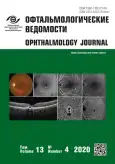高眼压对眼球内部结构应力状态变化影响的模拟
- 作者: Takhtaev Y.V.1, Shliakman R.B.1
-
隶属关系:
- St. Petersburg Pavlov Medical University of the Ministry of Health of Russia
- 期: 卷 13, 编号 4 (2020)
- 页面: 21-27
- 栏目: Original study articles
- URL: https://journals.rcsi.science/ov/article/view/56718
- DOI: https://doi.org/10.17816/OV56718
- ID: 56718
如何引用文章
详细
目的:本研究旨在超声乳化术中眼前房压力升高对眼球不同结构应力状态变化影响的模拟和评估。
材料和方法:通过有限元法建立了一个简化的眼球轴对称解剖模型。使用Deform软件包,可以通过计算超声乳化过程中,眼球前房内多余压力的重新分布对眼球各个结构应力状态的变化,解决了眼球变形问题。
结果:在处理模拟结果的过程中,获得了应用于眼球前房的超压在眼球后极部方向减少重新分布的数据。压力水平为施加的超压的0.85%。获得的数据从少数动物实验中得到了证实。
结论:我们提出的眼压增高对眼球不同结构应力状态变化影响的模拟表明,眼球血流维持在恒定水平的自动调节机制包括玻璃体的弹性特性导致眼压急剧上升的补偿机制。这个模拟可以计算出眼球不同部位的压力再分配,这取决于玻璃体弹性特性的状态,以及无玻璃体眼和硅油填充的情况。
作者简介
Yuri Takhtaev
St. Petersburg Pavlov Medical University of the Ministry of Health of Russia
Email: ytakhtaev@gmail.com
MD, Professor of the Ophthalmology Department. I.P. Pavlov First St. Petersburg State Medical University of the Ministry of Healthcare of Russia
俄罗斯联邦, St. PetersburgRoman Shliakman
St. Petersburg Pavlov Medical University of the Ministry of Health of Russia
编辑信件的主要联系方式.
Email: romanshlyakman@gmail.com
Resident of Ophthalmology department. I.P. Pavlov First St. Petersburg State Medical University of the Ministry of Health of Russia
俄罗斯联邦, St. Petersburg参考
- Malik PK, Dewan T, Patidar AK, Sain E. Effect of IOP based infusion system with and without balanced phaco tip on cumulative dissipated energy and estimated fluid usage in comparison to gravity fed infusion in torsional phacoemulsification. Eye Vis (Lond). 2017;4(1):22. https://doi.org/10.1186/s40662-017-0087-5
- Hejsek L, Kadlecova J, Sin M, et al. Intraoperative intraocular pressure fluctuation during standard phacoemulsification in real human patients. Biomed Pap Med Fac Univ Palacky Olomouc Czech Repub. 2019;163(1):75-79. https://doi.org/10.5507/bp.2018.065.
- Khng C, Packer M, Fine IH, et al. Intraocular pressure during phacoemulsification. J Cataract Refract Surg. 2006;32(2):301-308. https://doi.org/10.1016/j.jcrs.2005.08.062
- Астахов Ю.С. Основные показатели кровообращения глаза и клинические методы их исследования // Методы исследования микроциркуляции в клинике: Материалы науч. – практ. конференции / под ред. Ю.С. Астахова, Г.В. Ангелопуло. – СПб., 2001. – С. 96–100. [Astakhov YuS. Osnovnye pokazateli krovoobrashcheniya glaza i klinicheskie metody ikh issledovaniya. Proceedings of the Russian science conference “Metody issledovaniya mikrotsirkulyatsii v klinike”. Astakhov YuS, Angelopulo GV, eds. Saint Petersburg; 2001. P. 96-100. (In Russ.)]
- Alm A. Ocular circulation. In: Adler’s physiology of the eye. Hart WM, ed. St. Louis, Baltimore: Mosby; 1992. P. 198-227.
- Cioffi GA, Granstam E, Alm A, et al. Ocular circulation. In: Adler’s physiology of the eye. Kaufmann PL, Alm A, eds. St. Louis, London: Mosby; 2003. P. 747-784.
- Sehi M, Flanagan JG, Zeng L, et al. Relative change in diurnal mean ocular perfusion pressure: a risk factor for the diagnosis of primary open-angle glaucoma. Invest Ophthalmol Vis Sci. 2005;46(2):561-567. https://doi.org/10.1167/iovs.04-1033
- Nagel E, Vilser D, Fuhrmann G, et al. Dilatation großer Netzhautgefäße nach Intraokulardrucksteigerung. [Dilatation of large retinal vessels after increased intraocular pressure]. (In German.) Ophthalmologe. 2000;97(11):742-747. https://doi.org/10.1007/s003470070021
- Nagel E, Vilser W. Autoregulative behavior of retinal arteries and veins during changes of perfusion pressure: a clinical study. Graefes Arch Clin Exp Ophthalmol. 2004;242(1):13-17. https://doi.org/10.1007/s00417-003-0663-3
- Волков В.В. Глаукома при псевдонормальном давлении. Руководство для врачей. – М.: Медицина; 2001. – 350 с. [Volkov VV. Glaukoma pri psevdonormal’nom davlenii. Rukovodstvo dlja vrachej. Moscow: Medicina; 2001. 350 p. (In Russ.)]
- Srirekha A, Bashetty K. Infinite to finite: an overview of finite element analysis. Indian J Dent Res. 2010;21(3):425-432. https://doi.org/10.4103/0970-9290.70813
- Fernández CD, Niazy AM, Kurtz RM, et al. Finite element analysis applied to cornea reshaping. J Biomed Opt. 2005;10(6):064018. https://doi.org/10.1117/1.2136149
- Ayyalasomayajula A, Park RI, Simon BR, Vande Geest JP. A porohyperelastic finite element model of the eye: the influence of stiffness and permeability on intraocular pressure and optic nerve head biomechanics. Comput Methods Biomech Biomed Engin. 2016;19(6):591-602. https://doi.org/10.1080/10255842.2015.1052417
- Grytz R, Krishnan K, Whitley R. et al. A Mesh-Free Approach to Incorporate Complex Anisotropic and Heterogeneous Material Properties into Eye-Specific Finite Element Models. Comput Methods Appl Mech Eng. 2020;(1):358. https://doi.org/10.1016/j.cma.2019.112654
- Olsen T, Ehlers N. The thickness of the human cornea as determined by a specular method. Acta Ophthalmologica. 1984;62(6): 859-871. https://doi.org/10.1111/j.1755-3768.1984.tb08436.x
- Hoffer KJ, Savini G. Anterior chamber depth studies. J Cataract Refract Surg. 2015;41(9):1898-1904. https://doi.org/10.1016/j.jcrs.2015.10.010
- Sebag J. Vitreous Anatomy, Aging, and Anomalous Posterior Vitreous Detachment. In: Encyclopedia of the Eye. Dartt DA, ed. Academic Press; 2010. P. 307-315. https://doi.org/10.1016/B978-0-12-374203-2.00256-6
- Olsen TW, Aaberg SY, Geroski DH, Edelhauser HF. Human sclera: thickness and surface area. Am J Ophthalmol. 1998;125(2): 237-241. https://doi.org/10.1016/s0002-9394(99)80096-8
- Invernizzi A, Cigada M, Savoldi L. In vivo analysis of the iris thickness by spectral domain optical coherence tomography. Br J Ophthalmol. 2014;98(9):1245-1249. https://doi.org/ 10.1136/bjophthalmol-2013-304481
- Okamoto Y, Okamoto F, Nakano S, Oshika T. Morphometric assessment of normal human ciliary body using ultrasound biomicroscopy. Graefes Arch Clin Exp Ophthalmol. 2017;255(12): 2437-2442. https://doi.org/10.1007/s00417-017-3809-4.
- Rasheed MA, Singh SR, Invernizzi A, et al. Wide-field choroidal thickness profile in healthy eyes. Sci Rep. 2018;8(1):17166. https://doi.org/10.1038/s41598-018-35640-9
- Giani A, Cigada M, Choudhry N, et al. Reproducibility of retinal thickness measurements on normal and pathologic eyes by different optical coherence tomography instruments. Am J Ophthalmol. 2010;150(6):815-824. https://doi.org/10.1016/j.ajo.2010.06.025.
- Topcu H, Altan C, Cakmak S, et al. Comparison of the lamina cribrosa parameters in eyes with exfoliation syndrome, exfoliation glaucoma and healthy subjects. Photodiagnosis and Photodynamic Therapy. 2020;31:101832. https://doi.org/10.1016/j.pdpdt.2020.101832
- Azhdam AM, Goldberg RA, Ugradar S. In Vivo Measurement of the Human Vitreous Chamber Volume Using Computed Tomography Imaging of 100 Eyes. Trans Vis Sci. Tech. 2020;9(1):2. https://doi.org/10.1167/tvst.9.1.2
- Иомдина Е.Н., Бауэр С.М., Котляр К.Е. Биомеханика глаза: теоретические аспекты и клинические приложения / под ред. Нероева В.В. – М.: Реал Тайм, 2015. – 208 c. [Iomdina EN, Baujer SM, Kotljar KE. Biomehanika glaza: teoreticheskie aspekty i klinicheskie prilozhenija. Neroeva VV, ed. Moscow: Real Tajm; 2015. 208 p. (In Russ.)]
- Sit AJ, Lin SC, Kazemi A, et al. In Vivo Noninvasive Measurement of Young’s Modulus of Elasticity in Human Eyes: A Feasibility Study. J Glaucoma. 2017;26(11):967-973. https://doi.org/ 10.1097/IJG.0000000000000774
- Jones IL, Warner M, Stevens JD. Mathematical modelling of the elastic properties of retina: a determination of Young’s modulus. Eye (Lond). 1992;6(Pt 6):556-559. https://doi.org/10.1038/eye.1992.121
- Tram NK, Swindle-Reilly KE. Rheological Properties and Age-Related Changes of the Human Vitreous Humor. Front Bioeng Biotechnol. 2018;6:199. https://doi.org/ 10.3389/fbioe.2018.00199.
- Nagae K, Sawamura H, Aihara M. Investigation of intraocular pressure of the anterior chamber and vitreous cavity of porcine eyes via a novel method. Scientific Reports. 2020;10:20552. https://doi.org/10.1038/s41598-020-77633-7
补充文件













